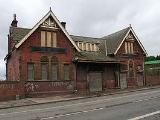
Possil railway station
Encyclopedia
Possil railway station was situated on Balmore Road, in the north of Glasgow
, Scotland
and served the Possilpark
and Parkhouse areas of the city.
, it served as the terminus for passenger services, but allowed for through services for the transport of freight. Services ran from Rutherglen
to Possil, via Glasgow Central Railway
.
There was a goods yard at the site of the station, which was closed as part of the Beeching Axe
. A scrapyard now occupies the site, although the station building and goods shed are still standing. The building has a slightly similar design to the now extinct Botanic Gardens
structure on the Glasgow Central Railway
. It has the company monogram "CR" carved in the stone above the two windows on the building's left frontal facade. It was in use as a bookmakers for many years in the 80s and 90s but by 2006, it was empty and falling into disrepair. It is now protected as a category C(S) listed building.
Glasgow
Glasgow is the largest city in Scotland and third most populous in the United Kingdom. The city is situated on the River Clyde in the country's west central lowlands...
, Scotland
Scotland
Scotland is a country that is part of the United Kingdom. Occupying the northern third of the island of Great Britain, it shares a border with England to the south and is bounded by the North Sea to the east, the Atlantic Ocean to the north and west, and the North Channel and Irish Sea to the...
and served the Possilpark
Possilpark
Possilpark is a district in the Scottish city of Glasgow, situated north of the River Clyde. Following the closure of the Saracen Foundry in 1967, this section of Glasgow has become one of the poorest in the United Kingdom, with an above average crime rate....
and Parkhouse areas of the city.
History
Part of the Lanarkshire and Dunbartonshire RailwayLanarkshire and Dunbartonshire Railway
- Early days :The Lanarkshire and Dunbartonshire Railway was authorised in 1891, and opened in stages between 26 November 1894 and 1 October 1896.On 16 August 1909 the Lanarkshire and Dunbartonshire Railway was absorbed into the Caledonian Railway...
, it served as the terminus for passenger services, but allowed for through services for the transport of freight. Services ran from Rutherglen
Rutherglen
Rutherglen is a town in South Lanarkshire, Scotland. In 1975, it lost its own local council and administratively became a component of the City of Glasgow. In 1996 Rutherglen was reallocated to the South Lanarkshire council area.-History:...
to Possil, via Glasgow Central Railway
Glasgow Central Railway
The Glasgow Central Railway was a railway that ran from Maryhill in the north west of Glasgow through the West End and City Centre to Rutherglen and Newton to the south east of the city.- Early days :...
.
There was a goods yard at the site of the station, which was closed as part of the Beeching Axe
Beeching Axe
The Beeching Axe or the Beeching Cuts are informal names for the British Government's attempt in the 1960s to reduce the cost of running British Railways, the nationalised railway system in the United Kingdom. The name is that of the main author of The Reshaping of British Railways, Dr Richard...
. A scrapyard now occupies the site, although the station building and goods shed are still standing. The building has a slightly similar design to the now extinct Botanic Gardens
Botanic Gardens railway station
Botanic Gardens railway station was a railway station serving the Botanic Gardens located in the Kelvinside area in the West End of Glasgow.-History:...
structure on the Glasgow Central Railway
Glasgow Central Railway
The Glasgow Central Railway was a railway that ran from Maryhill in the north west of Glasgow through the West End and City Centre to Rutherglen and Newton to the south east of the city.- Early days :...
. It has the company monogram "CR" carved in the stone above the two windows on the building's left frontal facade. It was in use as a bookmakers for many years in the 80s and 90s but by 2006, it was empty and falling into disrepair. It is now protected as a category C(S) listed building.

